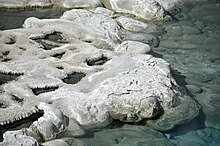Artemisia Geyser
The geyser was named in 1883 by geologist Walter Weed after Artemisia tridentata (Big Sagebrush), a common plant in the Yellowstone National Park area, due to the color of the sinter deposits on the south and southwest sides of the crater.[3] Artemisia Geyser was not referenced in the findings of the Hayden Geological Survey in 1881 (likely due to inaccessibility and inconspicuousness--around one eruption per day), and only referred to as a spring until 1886.Historian Lee Whittlesey cites geologist Arnold Hague's description of the geyser:It lies back from the river, not far from the edge of the forest, a large, irregular shaped pool 55 by 60 feet...The deposits lining the pool are pure white except along the border, or where they are under water much of the time, in which case they present a peculiar olive-green tint characteristic of this particular spring.[5] Major eruptions cause a heavy deluge of discharged water and a large steam cloud if the weather is cold or humid.


Teton County, WyomingCoordinatesgeyserYellowstone National ParkUnited StatesArtemisia tridentatasinterHayden Geological SurveyspringArnold Hague'sAtomizer GeyserMontana State UniversityYouTubeUpper Geyser BasinAnemone GeyserAurum GeyserBaby Daisy GeyserBeehive GeyserBig Cub GeyserBijou GeyserBulger GeyserCastle GeyserComet GeyserDaisy GeyserEconomic GeyserFan and Mortar GeysersGiant GeyserGiantess GeyserGrand GeyserGrotto GeyserJewel GeyserLion GeyserLone Star GeyserOld Faithful GeyserPenta GeyserPump GeyserRiverside GeyserSawmill GeyserSolitary GeyserSpasmodic GeyserSplendid GeyserTurban GeyserVent GeyserWest Triplet GeyserBeauty PoolBelgian PoolBrilliant PoolCrested PoolChromatic SpringDoublet PoolMorning Glory PoolEar SpringHamilton's StoresOld Faithful InnOld Faithful Historic DistrictOld Faithful LodgeOld Faithful Museum of Thermal ActivityCraig PassIsa LakeKepler CascadesFirehole RiverMystic FallsList of Yellowstone National Park related articlesWyomingCheyenneBibliographyGovernorsDelegationsHistoryPeopleState symbolsRadio stationsAbortionClimate changeDemographicsEconomyEducationGun lawsLGBT rightsPoliticsBlack HillsGrand TetonGreat BasinPowder River CountryRed DesertYellowstoneCitiesBuffaloCasperDouglasEvanstonGilletteGreen RiverJacksonKemmererLanderLaramieNewcastlePowellRawlinsRivertonRock SpringsSheridanTorringtonWorlandCountiesAlbanyBig HornCampbellCarbonConverseFremontGoshenHot SpringsJohnsonLincolnNatronaNiobraraPlatteSubletteSweetwaterWashakieWeston